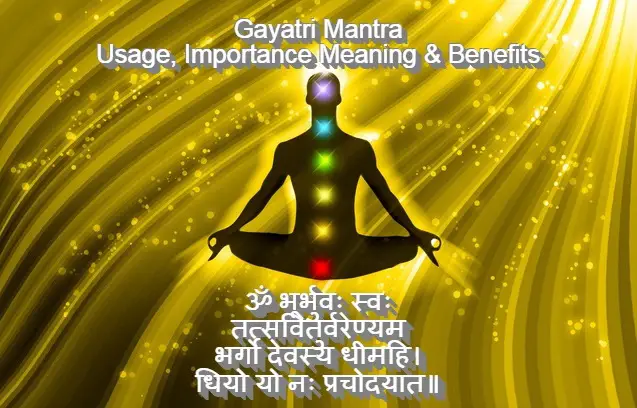Understanding the Gayatri Mantra : Mantras are an important tool towards self-improvement and spiritual upliftment in the yogic tradition. The Gayatri Mantra is one of the most highly revered, as well as one of the most chanted mantras. This is because it is said to bestow blessings in the lives of children and adults alike.
The Gayatri Mantra is three-fold in purpose: it praises, leads to meditation and ends with a prayer. It proclaims reverence to the goddess Gayatri. Read on to fill up your knowledge base about this famous mantra.
Who Is Gayatri Devi?
There are various interpretations of the name Gayatri. But, most importantly, Gayatri is called Mata, or Mother of the Vedas. She is credited with great positive power. She is known as the protector of the five elements that make a man’s being, also called the five pranas. She has different names through her other roles: Savitri – the protector of life-forces, and Sarasvati – the protector of speech. In and through these different roles, Gayatri is revered as the embodiment of all the goddesses.
The devotees of Gayatri Devi depict her as a feminine form with five heads and ten hands, seated on a red lotus. These are depicted in various mudras or poses, depicting various attributes of the goddess. She is regarded a boon-giver, protector, and the one who combats ignorance and bestows wisdom and power.
The Gayatri Mantra
The Gayatri Mantra represents the essence of the Vedas. There are three parts to the Gayatri:
- Adoration and praise of the Divine
- Meditation upon the Divine
- Prayer to the Divine to awaken the intellect and strengthen it.
This summarizes all of the Vedas into a concise verse. The five faces of Gayatri, or five aspects of her being are seen in the lines of the prayer. The Om is the first face, Bhur-bhuvah-svah is the second, Tat-savitur-Varenyam the third, and so on. Dhimahi is the part that involves meditation in the mantra. Dhiyo Yonah Prachodayat is the prayer being made to the divine.
In some places, Gayatri is the poetic meter in the Vedic poetic tradition in which the mantra was written. Maharishi Vishwamitra, one of the most revered sages in ancient India, created the mantra. He is also credited with authoring Mandala 3 of the Rigveda. It also has a place of divine importance in the Upanishads and the Bhagavad Gita. According to ancient traditions, men found the sun as the embodiment of the transcendent power they sought to find proof for. They saw that the sun was the most important source of light and life on the earth. This was what Vishwamitra sought to embody in the Gayatri Mantra.
Usage And Importance
The importance of the Gayatri Mantra can be clearly seen when we examine where and when it is traditionally used.
- The Upanayana Ceremony: the mantra is an integral part of the Upanayana ceremony which marks the acceptance of a student by a guru, or the initiation of a young Hindu man into a Hindu religious school. In this context, it is also called the Gayatri diksha, or initiation into the Gayatri mantra. This initiation is caste sensitive. This means certain parts of the mantra are used for Brahmin boys. Certain variations of the mantra are used for non-Brahmans.
- From their early years, the elitist Brahmos of the Brahmo Samaj have used the Gayatri Mantra for their private worship.
- The Gayatri Mantra had a pivotal role in the Hindu revivalism movement in the 19th century. Reformers like Swami Vivekananda popularized the mantra and used it as an equalizer, effectively rejecting caste distinction.
- The mantra has spread beyond borders. It forms part of the Balinese Hindus’ Trisandhya Puja.
- The popularity of the mantra can also be seen in its adaptation into popular culture. A number of music artists have had the Gayatri Mantra adapted into their albums including Cher and the avant-garde black metal band Schmasch, among others.
Meanings And Interpretations
| In English: | In Sanskrit: |
| Om Bhur Bhuvaḥ Swaḥ Tat-savitur Vareñyaṃ Bhargo Devasya Dheemahi Dhiyo Yonaḥ Prachodayāt | ॐ भूर्भुवः स्वः तत्सवितुर्वरेण्यम भर्गो देवस्य धीमहि। धियो यो नः प्रचोदयात॥ |
A number of pandits and respected rishis have given their interpretations of the Gayatri Mantra, but the universal theme of the mantra remains the realization of the thread of Oneness that runs throughout Creation. This is represented in many ways in the interpretation of the mantra. Bhur, Bhuvah, and Swaha, represented as goddesses Gayatri, Savitri, and Sarasvati are “latent” in everyone. The Goddess Gayatri is described as the mother of all scriptures, or the mother of all Vedas. Satyasai.org presents her as a very powerful being. The article here states that she is present wherever her name is chanted in a mantra. She seems to be presented as the all-encompassing being – an embodiment of all the goddesses. This mantra in her honor is given the same value.
Here is a word-for-word breakdown of the words in the mantra for better understanding:
| Mantra | Meaning |
| Om: | The Primeval sound that begins most mantras. It is the sound of the Universe. |
| Bhur: | The physical body, or the physical realm |
| Bhuvah: | life source, could also stand for the mental realm |
| Suvah: | life source, could also stand for the mental realm |
| Tat Savitur: | that sun god, the Creator, the Source of all life |
| Varenyam Bhargo: | expressing adoration to the divine light |
| Devasya: | The Supreme Lord |
| Dhimahi: | to mediate (on) |
| Dhiyo: | the divine intellect |
| Yo: | Oh! May this light |
| Nah: | (literally) our |
| Prachodayat: | illuminate, or inspire |
How To Recite The Gayatri Mantra
The Gayatri Mantra is said to be greatly potent when chanted in the proper manner. Pronunciation is as important as any other ritual and experts recommend that devotees learn the right manner of pronunciation before starting the ritual. Best practices would include starting the recitation in the morning after a cleansing bath. The chant is best recited facing the sun in a seated position with the hands folded. The ideal number of times the mantra is to be repeated is 108 times, though starting with 21 is the most common practice. The most ideal times to recite the mantra would be dawn, mid-day, and dusk, in accordance with the movement of the sun.
Benefits Of Chanting The Gayatri Mantra
Every mantra is supposed to bring a certain combination of blessings and positive influences in the life of the devotee. As one of the most powerful of the yogic chants, the Gayatri Mantra has its own set of blessings for its devotees. Let’s look at a few of them:
- Consistent and mindful chanting of the Gayatri Mantra enables the devotee to find his purpose. According to the revered Sathya Sai Baba, this is achieved when the chanting of the Gayatri Mantra cleanses and ‘sublimates’ the physical, metaphysical, and the psychical elements or instruments of his being.
- It forms a protective shield around the devotee. Saibaba states that chanting the mantra in the right accent, as put down in the Vedas, creates an atmosphere of illuminated deification around the devotee – the ‘divine effulgence’, also called Brahma-prakāsha descends on the devotee and acts as a source of wisdom and guidance. Additionally, chanting Shanti three times at the end of the mantra recitation brings peace into the three instruments: the body, mind, and soul of the devotee.
- The chanting of the Gayatri Mantra acts as a sort of atonement for wrongdoing in the life of the devotee. It acts as a means of negating karma. This means that the negative karma which is accumulated as a result of the devotee’s wrongdoings is atoned for when this mantra is repeated. Saibaba recommends that the mantra be chanted three times a day so that every day’s karmic debt is dealt with immediately.
- Gayatri Mata is said to be the ‘bestower of all that is beneficial’. She relieves all diseases, wards off all evil, and fulfills all desires. Chanting the Gayatri Mantra in praise of this goddess is claimed to bestow the devotee with a number of positive energies and beneficial powers.
- One of the greatest benefits of the Gayatri Mantra is greater mental clarity and ability. It is, therefore, suited to the use of children, as well as adults, particularly the elderly.
In a nutshell, regular and proper recitation of the Gayatri Mantra can be a practice that bestows the devotee with the blessings and benefits of all the sacred mantras put together.
SOURCES
www.sathyasai.org/
https://www.yogajournal.com/
https://greenmesg.org
https://en.wikipedia.org



